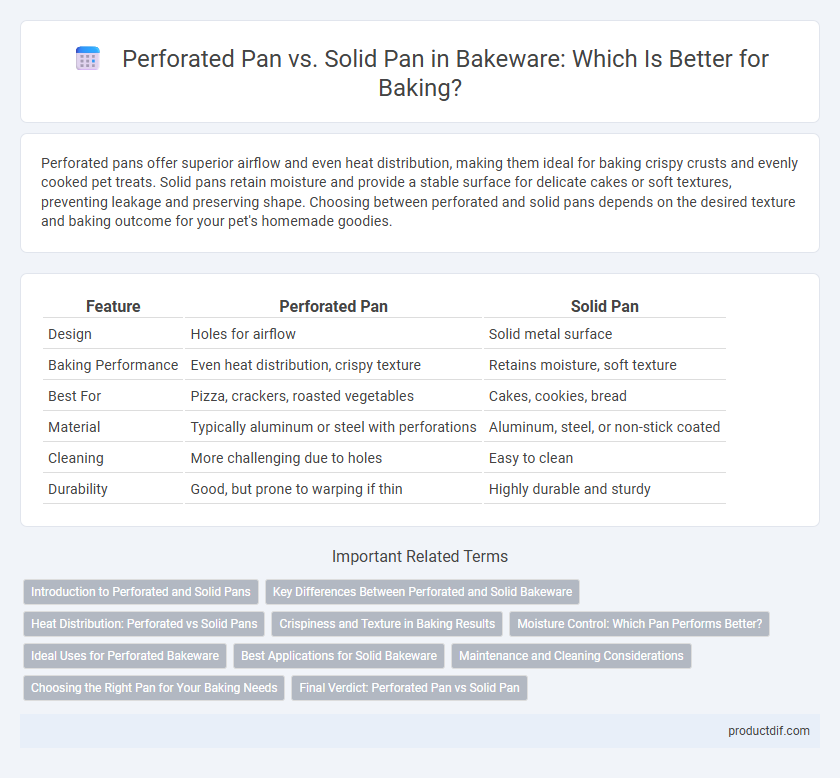Perforated pans offer superior airflow and even heat distribution, making them ideal for baking crispy crusts and evenly cooked pet treats. Solid pans retain moisture and provide a stable surface for delicate cakes or soft textures, preventing leakage and preserving shape. Choosing between perforated and solid pans depends on the desired texture and baking outcome for your pet's homemade goodies.
Table of Comparison
| Feature | Perforated Pan | Solid Pan |
|---|---|---|
| Design | Holes for airflow | Solid metal surface |
| Baking Performance | Even heat distribution, crispy texture | Retains moisture, soft texture |
| Best For | Pizza, crackers, roasted vegetables | Cakes, cookies, bread |
| Material | Typically aluminum or steel with perforations | Aluminum, steel, or non-stick coated |
| Cleaning | More challenging due to holes | Easy to clean |
| Durability | Good, but prone to warping if thin | Highly durable and sturdy |
Introduction to Perforated and Solid Pans
Perforated pans feature small holes that promote even heat circulation and allow moisture to escape, making them ideal for baking items like bread and pizza crusts where crispiness is desired. Solid pans have a continuous surface that provides uniform heat distribution and retain moisture, perfect for cakes, brownies, and other baked goods requiring a tender crumb. Choosing between these pans depends on the desired texture and baking technique, with perforated pans offering enhanced airflow and solid pans ensuring consistent moisture retention.
Key Differences Between Perforated and Solid Bakeware
Perforated pans feature small holes that allow hot air to circulate evenly, producing crispier crusts and faster baking times, especially for bread and pizza. Solid pans provide uniform heat distribution and better moisture retention, making them ideal for cakes, cookies, and delicate pastries that require a softer texture. Choosing between perforated and solid bakeware depends on whether the recipe benefits more from airflow and crispiness or moisture retention and even cooking.
Heat Distribution: Perforated vs Solid Pans
Perforated pans feature holes that allow hot air to circulate evenly around the food, promoting faster and more uniform heat distribution, ideal for baking crisp crusts. Solid pans, by contrast, retain heat through their continuous surface, providing steady, consistent heat but with less airflow, which can result in softer textures and slower baking times. Understanding these heat distribution differences helps bakers choose the right pan type for desired outcomes like crispness or moisture retention.
Crispiness and Texture in Baking Results
Perforated pans enhance airflow and heat circulation, resulting in crispier crusts and evenly textured baked goods like pizzas and bread. Solid pans retain moisture more effectively, producing softer textures with tender crumb structures ideal for cakes and delicate pastries. Choosing between perforated and solid pans directly impacts the crispiness and texture outcomes of your baking projects.
Moisture Control: Which Pan Performs Better?
Perforated pans excel in moisture control by allowing steam to escape through tiny holes, preventing sogginess and promoting crispier crusts for baked goods like pizza and bread. Solid pans trap moisture, which can result in softer, chewier textures ideal for cakes and dense pastries that require moisture retention. Choosing between perforated and solid pans depends on the desired moisture level and texture of the final bake.
Ideal Uses for Perforated Bakeware
Perforated bakeware is ideal for baking items that benefit from enhanced air circulation and even heat distribution, such as pizza crusts, bread, and crispy pastries. The perforations allow moisture to escape, resulting in a crispier texture and preventing sogginess commonly seen with solid pans. Professional bakers often choose perforated pans to achieve a uniformly browned crust and faster baking times.
Best Applications for Solid Bakeware
Solid bakeware pans excel in retaining moisture and evenly distributing heat, making them ideal for baking cakes, brownies, and custards where a uniform texture is essential. Their non-perforated surface prevents batter from leaking, ensuring smooth edges and consistent rising. Use solid pans for dense or delicate baked goods that require steady, controlled heat without airflow.
Maintenance and Cleaning Considerations
Perforated pans require more careful cleaning to prevent food particles from becoming trapped in the holes, often necessitating a brush or specialized tools for thorough maintenance. Solid pans are easier to clean due to their smooth, uninterrupted surfaces, which resist residue buildup and reduce the need for intensive scrubbing. Both types benefit from non-abrasive cleaning agents and prompt washing to preserve coating integrity and prevent rust.
Choosing the Right Pan for Your Baking Needs
Perforated pans provide superior air circulation, resulting in evenly baked, crispier crusts ideal for bread and pizza. Solid pans retain moisture better, making them perfect for cakes, cookies, and other delicate baked goods requiring a tender crumb. Selecting the right pan depends on the desired texture and baking item, ensuring optimal heat distribution and finished product quality.
Final Verdict: Perforated Pan vs Solid Pan
Perforated pans provide superior air circulation and moisture release, resulting in crispier crusts and evenly baked goods, ideal for artisan bread and pizzas. Solid pans offer more versatility and better heat retention, making them suitable for cakes, cookies, and items requiring consistent moisture. Choosing between perforated and solid pans depends on the specific baking needs, with perforated pans excelling in texture enhancement and solid pans ensuring uniform baking for delicate recipes.
Perforated Pan vs Solid Pan Infographic

 productdif.com
productdif.com